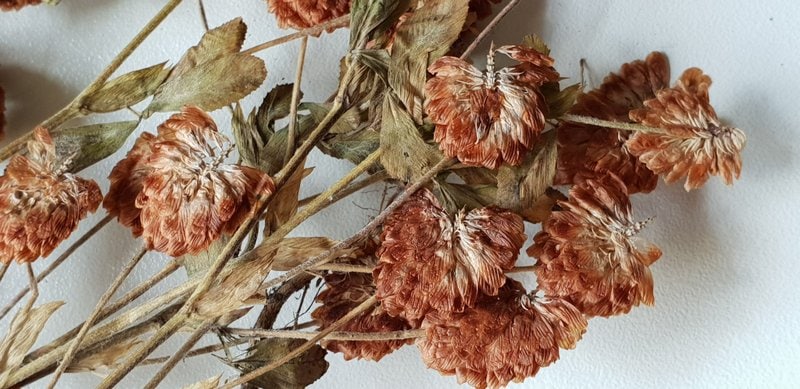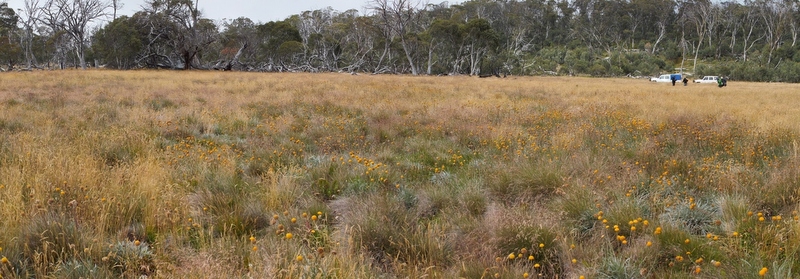All that glitters is not gold when it comes to Australia’s newest weed. The previously unrecorded species of clover, found during TERN’s survey of Australia’s alpine region, has just been identified as Golden Clover. Native to Europe and never found in Australia before, find out how Trifolium aureum was spotted and what the discovery may mean for our native ecosystems.
On the afternoon of 10 October 2018, Neville Walsh of Royal Botanic Gardens Victoria made a startling discovery. Working with plant samples collected during TERN’s terrestrial ecosystem mapping of Australia’s alpine region, Neville had just identified Australia’s newest weed species: Golden Clover (Trifolium aureum).
“It’s quite rare to make new discoveries for Australia,” says Neville. “We’d be lucky to record new ‘national’ species once a year. The great majority of new weed species are ones that ‘jump the fence’ from horticulture, but Golden Clover seems to have sprung from nowhere!”
Anna Monro of Parks Australia’s Biodiversity Science Section and a co-compiler of the Australian Plant Census says “In the last five years, only 15 weedy plant species have been newly recorded in our Census for the Victorian flora but T. aureum is the only legume.”
Native to eastern and central Europe, Golden Clover is not known to occur elsewhere in Australia except where it was found by TERN on Victoria’s Dargo High Plains south-west of Mt Hotham in January 2018.

Systematic surveys spot ‘slow-burn’ species
While the discovery of Golden Clover in Australia is significant, it does not necessarily indicate the species is a recent introduction.
“My feeling is that the species is unlikely to be a new arrival and more likely to have been a ‘slow burn’ in the area, perhaps not brilliantly adapted to the Dargo Plains conditions and not able to spread extensively,” says Neville.
Dr Greg Guerin, an ecologist at the University of Adelaide with considerable expertise in Australian weed species, agrees with Neville and says that similarities to other clover species could have led to Golden Clover being overlooked in the past.
“The discovery is the result of the systematic monitoring of all species at TERN’s monitoring sites, followed up with retention and formal identification of voucher specimens,” says Greg.
“The identification of this new species reinforces the value of the TERN AusPlots methodology for the surveillance of Australia’s ecosystems.”

Implications for native biodiversity unknown
Some of Golden Clover’s closest relatives (Trifolium campestre and T. dubium) are common in Australia but rarely considered seriously invasive in native vegetation. Moreover, Golden Clover is established as an introduced species elsewhere, including Japan and North America, where it is not considered problematic.
“That said, the specimen I received had abundant seed, so recruitment is certainly possible,” says Neville. “And, maybe with changing climate, progeny might be able to survive more successfully under warmer climate scenarios.”
Greg says that the potential impacts of Golden Clover on Australian native plant diversity are unknown.
“In Australia, many exotic herbs can co-exist in grasslands with natives, but some species are problematic and cause declines in native species diversity or abundance. It isn’t clear at this stage whether the species is a long-term but infrequent resident, or one that is likely to expand its range and cause problems.
It’s not known how common Golden Clover is in the Australian alps, but surveys at the TERN ecosystem surveillance alpine plots this summer by Royal Botanic Gardens Victoria staff are expected to determine if the population is large enough to be of concern to native vegetation.
Future repeat TERN surveys will also detect any significant increases in frequency or abundance of the species, a finding that could trigger more targeted monitoring or management. So watch this space for more updates on our golden interloper from Europe.
- FAIR data collected from TERN’s network of over 580 ecosystem surveillance plots is recorded and made publicly available through TERN’s AEKOS data portal. Soil and plant samples are made available in the TERN Ecosystem Sample Library and also contributed to the CSIRO National Soil Archive and regional herbaria.
- For more information on TERN’s Ecosystem Surveillance capability click here or contact Associate Professor Ben Sparrow.
This afternoon #RBGVScience Neville Walsh determined an unknown species of yellow-flowered clover from Victoria’s high country as Trifolium aureum. Collected during a @TERN_Aus survey, it is native to Europe. VicFlora updated today https://t.co/1wxuTAp6Mu #plants pic.twitter.com/pRv32yeI9m
— Frank Udovicic (@FrankUdovicic) October 10, 2018






